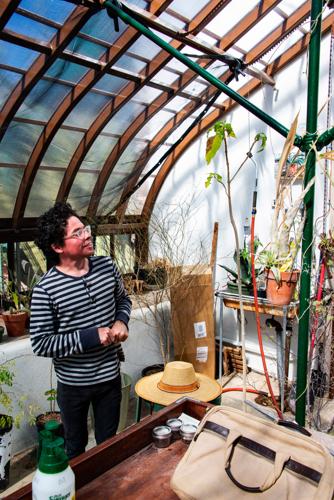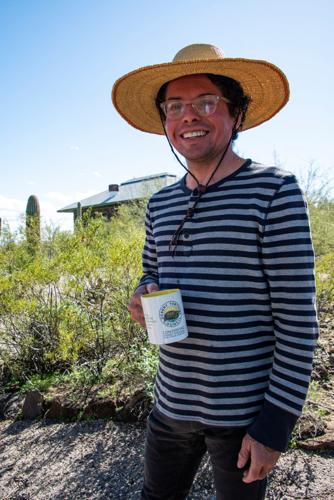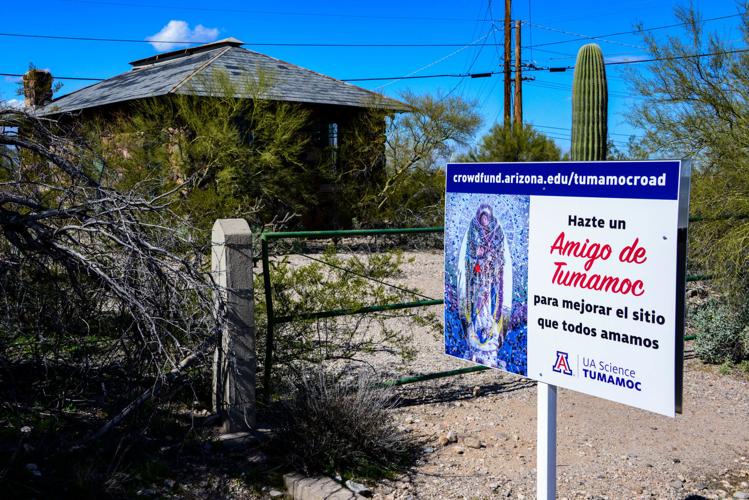ENGLISH VERSION BELOW
Cuando era niño, Robert Villa y su abuela caminaban desde su casa en Menlo Park hasta Tumamoc Hill y se preguntaban qué hacían en esos edificios de piedra allá arriba.
Hoy dirige el invernadero del laboratorio en Tumamoc Hill, quizás el más antiguo del estado, y tuvo la feliz ocasión de llevar a su abuela allí y mostrarle de primera mano lo que sucede en el centro de investigación junto al que tantas personas pasan mientras caminan por el cerro.
Villa es un hombre genuinamente renacentista con una visión global de Tucsón y el desierto de Sonora. Experto en gran parte autodidacta y bien educado sobre desierto, plantas, lagartos, serpientes, animales y terreno geológico, el nativo de Tucsón de 34 años se ha convertido en un invaluable asistente de investigación para el equipo ecológico de la Universidad de Arizona en Tumamoc, así como para los arqueólogos que trabajan allí.

Robert Villa dirige el invernadero del laboratorio de la Universidad de Arizona en el cerro Tumamoc, quizás el más antiguo del estado.
Villa acababa de regresar de ayudar al equipo en “un hallazgo arqueológico muy emocionante” en algún lugar de México (un secreto, por ahora) que había descubierto. Ahí documentó la ubicación de los artefactos a través de la fotografía y el equipo de ubicación GPS, tomó nota de la vegetación y la vida silvestre locales y, en general, “preparó el escenario” para que los arqueólogos interpretaran los tiempos en que estos artefactos fueron creados y cómo terminaron donde hoy están. Es un trabajo minucioso, y a él le encanta.
La instalación desértica de 880 acres de la universidad en Tumamoc Hill es el sitio ecológico más antiguo del planeta y el más largo estudiado continuamente. El observatorio en la parte superior es donde los investigadores del Laboratorio Lunar y Planetario de la Universidad de Arizona, Gerard Kuiper y Ewen Whitaker, hicieron los primeros mapas detallados de la luna a fines de la década de 1950, preparando el escenario para los alunizajes del Apolo.
En el invernadero de Tumamoc donde es curador, Villa cultiva varias plantas autóctonas de la colina y está preparando las instalaciones para su próxima función educativa. Construida hace más de un siglo y restaurada en los últimos años, la elegante estructura de vidrio y acero ha incorporado algunos desafíos relacionados con el calor del verano, que esperan abordar en los próximos meses.
Además del trabajo de Tumamoc, Villa asiste al curador de plantas y ex curador de botánica e historia natural del Museo del Desierto de Arizona, Mark Dimmitt, en su paraíso hortícola repleto de cactus, orquídeas y plantas exóticas. Villa también trabaja en Eco Grove Garden Store.

Robert Villa, nativo de Tucsón de 34 años, se ha convertido en un invaluable asistente de investigación para el equipo ecológico de la UA en Tumamoc por su conocimiento -en gran parte autodidacta- de la flora y fauna del desierto.
Su pasión por el desierto no tiene límites, y lo ha sido desde la infancia. De niño tuvo un lagarto (Gila monster) legalmente obtenido, una serpiente de cascabel y otras criaturas del desierto. Crió ratas para alimentarlos. Vagó por el desierto, aprendiendo todo lo que pudo sobre cada planta y criatura del desierto, sin cansarse nunca de la diversidad de formas y colores del desierto, que es su hogar.
Hace aproximadamente un año, me encontré en una caminata por el desierto con Villa y el escritor de Tucsón Greg McNamee mirando a los saguaros con cresta cerca de Sells cuando señaló un garabato en la arena de un lavado y me advirtió que me quedara donde estaba. Efectivamente, una serpiente de cascabal excavaba ahí.
Compartir sus conocimientos con amigos y visitantes es algo que ama tanto como sus propias experiencias solitarias en el desierto.
“Hago todo lo posible por apreciar cada puesta de sol y cada salida del sol y es por eso que me encanta mostrarlo a la gente, porque su emoción mantiene encendida mi llama”, dice. “Y cuanto más enseñas o muestras, más aprendes”.
Pero el mundo de la historia natural es solo un lado de la naturaleza dual de Villa. Cuando no está en el invernadero o en el sitio, es probable que esté frente a un atril tocando música clásica.
Como muchos mexicoamericanos de Tucsón, creció oyendo norteño, tex-mex y la música de la radio en español. Su padre amaba el rock, desde Aerosmith hasta The Cure, así que había mucho que escuchar en la casa de Villa. Sus primeros dos conciertos, ambos en El Casino Ballroom, fueron de Queen Ida & Her Zydeco Band y los Texas Tornados del Flaco Jiménez, Doug Sahm y Freddy Fender. Pero fue la música clásica mágica que provenía del gran tocadiscos Zenith de su abuela, y las transmisiones clásicas de KUAT, que fueron la banda sonora de su casa, lo que se quedó atorado en su oído.
Él y su abuela irían a la tienda de segunda de Saint Mary’s Auxiliary en Silverbell y St. Mary’s, donde urgaría entre los LP en busca de delicias para sus oídos. La famosa grabación de Jascha Heifetz del Concierto para Violín de Tchaikovsky con la Orquesta Sinfónica de Chicago impulsó su escucha clásica más seria, al igual que una grabación de Joshua Bell con brillantes arreglos de Fritz Kreisler. Se enamoró de la virtuosa pirotecnia de Paganini y Bruch, y comenzó una búsqueda inquebrantable de música para violín.

Robert Villa en Tumamoc Hill.
Villa empezó las clases de violín en cuarto grado, pero se comprometió más seriamente mientras asistía a Roskruge Middle School. Allí la maestra de orquesta Lee Oler vio algo especial en él y lo tomó bajo su ala. Ella organizó una tutoría privada con miembros de la Orquesta Sinfónica de Tucsón para alimentar su creciente talento musical.
Y reconociendo otra pasión, Oler lo introdujo en la Sociedad Herpetológica de Tucsón, la organización dedicada a la conservación, investigación y educación sobre anfibios y reptiles en Arizona y México. Miembro desde la escuela secundaria, Villa es ahora presidente de la agrupación.
Las presentaciones públicas de Villa son escazas. Ha colaborado con varios artistas de performance y músicos locales en pequeños escenarios aquí y allá; nada de manera regular. Pero si te topas con él en alguna parte, te espera un regalo. El tono y la fraseología de Villa son espectaculares, y su sed de conocimiento sobre la interpretación de la música es tan ilimitada como el desierto mismo. Toca con sentimiento y propósito.
“Cuento mis estrellas de la suerte, porque (tocar) hace la vida más significativa y expresiva”, dice. “Me ayuda a superar los momentos difíciles. Me hace darme cuenta de que no soy el único ser humano que siente estas cosas. Eso me da esperanza y razón para salir y estar en el mundo. Hace que los sucesos alegres sean más alegres. Realza todos tus sentimientos”.
ENGLISH VERSION
As a young boy, Robert Villa and his grandmother would walk from her Menlo Park home past Tumamoc Hill and wonder what they did in those stone buildings up there.
Today he runs the lab’s greenhouse on Tumamoc Hill – perhaps the oldest in the state – and had the joyful occasion of taking his grandmother there and showing her first-hand what goes on at the research facility that so many pass by as they walk the hill to get physically fit.
Villa is an honest-to-God renaissance man with a global vision of Tucson and the Sonoran Desert. A largely self-taught and well-mentored expert in all of the desert’s, plants, lizards, snakes, animals and geologic terrain, the 34-year-old Tucson native has become an invaluable research assistant to the University of Arizona’s ecological team on Tumamoc, as well as the archaeologists who work there. Villa had just returned from assisting the team at “a very exciting archaeological find” somewhere in Mexico (a secret for now) which he had co-discovered. There he documented the location of artifacts though photography and GPS location gear, made notes of the local vegetation and wildlife and generally “set the scene” for the archaeologists to interpret the times when these artifacts were created and how they ended up where they are today. It is painstaking work, and he loves it.
The university’s 880-acre desert facility on Tumamoc Hill is the oldest ecological site on the planet, and the longest continuously studied. The observatory at the top is where University of Arizona Lunar and Planetary Laboratory researchers Gerard Kuiper and Ewen Whitaker made the first detailed maps of the moon in the late-1950s, setting the stage for the Apollo moon landings.
At the Tumamoc greenhouse where he is curator, Villa grows various plants indigenous to the hill and is preparing the facility for its upcoming educational role. Built over a century ago and refurbished over the past few years, the graceful glass and steel structure has some built in challenges dealing with the summer heat, which they hope to address in the coming months.
In addition to the Tumamoc gig, Villa assists plantsman/former Arizona Desert Museum curator of botany and natural history Mark Dimmitt at his horticultural paradise overflowing with cacti, orchids and exotic plants. Villa also works at Eco Grove Garden Store.
His passion for the desert is boundless, and has been so since childhood. As a boy he had a legally-obtained Gila monster, a rattle snake and other desert creatures. He bred rats to feed them. He wandered the desert, learning all he could about every desert plant and creature, never tiring of the diversity of form and color of his desert home.
A year or so ago I found myself on a desert trek with Villa and Tucson author Greg McNamee, looking at crested saguaros near Sells when he pointed out a squiggle in the sand of a wash and cautioned me to stay where I was. Sure enough, a rattler was dug in there. Sharing his knowledge with friends and visitors is something he loves as much as his own solo desert experiences.
“I do my best to appreciate every sunset and every sunrise and that's why I love showing people around because their excitement keeps my flame burning,” he says. “And the more the more you teach or show, the more you learn.”
But the natural history world is only side of Villa’s dual nature. When he’s not in the greenhouse or on site somewhere he’s likely in front of a music stand playing classical music.
Like many Tucson Mexican Americans he grew up on norteño, Tex-Mex and the music on Spanish language radio. His dad loved rock, from Aerosmith to The Cure so there was plenty to listen to at the Villa home. His first two concerts – both at El Casino Ballroom – were Queen Ida’s zydeco band and Flaco Jimenez, Doug Sahm and Freddy Fender in the Texas Tornados. But it was the magical classical music that came from his grandmother’s big Zenith record player, and the KUAT classical broadcasts that were the soundtrack to her home, that got stuck in his ear.
He and his grandmother would go to the Saint Mary's Auxiliary thrift store on Silverbell and St. Mary’s where he’d rifle through the LPs in search of delights for the ear. The famous Jascha Heifetz recording of the Tchaikovsky Violin Concerto with the Chicago Symphony Orchestra jump-started his more serious classical listening, as did a Joshua Bell recording of bravura arrangements by Fritz Kreisler. He fell in love with the virtuosic pyrotechnics of Paganini and Bruch, and an unquenchable quest for violin music began.
Villa started violin lessons in fourth grade but became more seriously engaged while attending Roskruge Middle School. There orchestra teacher Lee Oler saw something special in him and took him under her wing. She arranged for private tutoring with members of the Tucson Symphony Orchestra to feed his growing musical talent. And recognizing another passion, Oler ushered him into the Tucson Herpetological Society – the organization dedicated to conservation, research and education on amphibians and reptiles in Arizona and Mexico. A member since middle school, Villa is president of the group today.
Public performances by Villa are rare. He has collaborated with a number of performance artists and local musicians in small settings here and there, but nothing on a regular basis. But if you stumble across him somewhere, you are in for a treat. Villa’s tone and phrasing are spectacular, and his thirst for knowledge about interpreting the music is as boundless as the desert itself. He plays with feeling and purpose.
“I count my lucky stars because (playing) makes life more meaningful and expressive,” he says. “It helps me get through hard times. It makes me realize that I'm not the only human being to feel these things. It that gives me hope and reason to get out and be in the world. It makes joyous events more joyful. It enhances all your feelings.”








